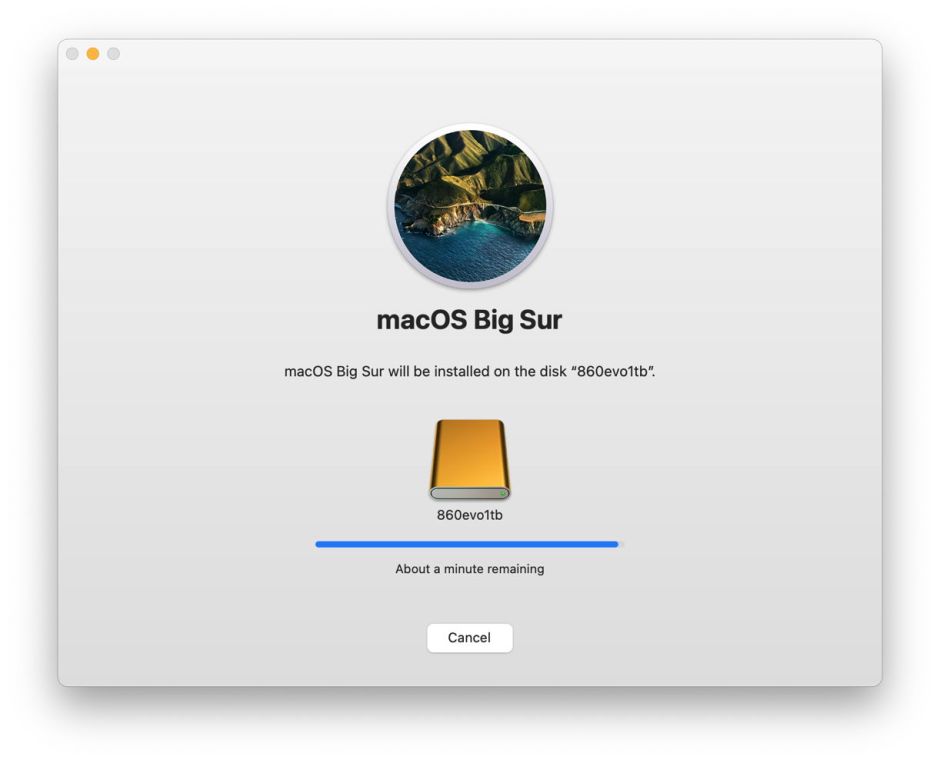Last week I described how I had been unable to get either of my M1 Macs to start up from an external disk. Thanks to many comments but no real clues, I’ve now been able to solve this, and here explain how you can do this too. Reliably.
You’ll need the following:
- an M1 Mac; if you haven’t got one yet, I’m afraid it’s far too late for Christmas;
- a Thunderbolt 3 SSD, such as a Samsung X5, freshly formatted in APFS (unencrypted) and connected to one of your M1 Mac’s Thunderbolt ports; if you only have SATA SSDs which connect via USB-C rather than Thunderbolt, you may be successful, but it seems unlikely. Some suggest that if your SSD isn’t Thunderbolt, try connecting it via a USB-A port, although that doesn’t help those with MacBook Air or Pro models;
- a copy of the Big Sur 11.1 (or later) installer app, obtained from the App Store via Software Update; this procedure appears less reliable in macOS 11.0.1 and when installing macOS 11.0.1, so 11.1 is recommended for both.
Connect your external disk, and if there’s any doubt about whether it has been freshly formatted using APFS without encryption, use Disk Utility to do so before going any further. Then open the Install macOS Big Sur app, and proceed. When it invites you to select the disk on which you want to install Big Sur, if you don’t see your external disk, click on the button to show all available disks. Then select the external disk and click Continue.

Follow the installation process through to completion. This should be relatively rapid, and at the end your Mac will automatically restart into the freshly installed copy of Big Sur on your external disk.
With AppleID and current setups, what you now effectively have is not simply another boot disk, but a whole new Mac bar the hardware. You’ll have to go through the whole process of setting your AppleID to work, negotiating two-factor authentication for this ‘new Mac’, and so on, until you can finally use your external disk fully.
When you want to restart from the internal disk, the Startup Disk pane is your best option. M1 Macs lack the old Startup Manager, and holding the Option key during startup does nothing at all. Its new equivalent is in the opening of Recovery Mode. In the first screen displayed there, rather than select the Options item to proceed to Recovery, select the disk which you want to boot from and click Continue underneath it. Your M1 Mac will then restart from the selected disk.
Once booted from the internal disk again, ejecting the bootable external disk isn’t fault-free. Clicking on the Eject tool for the System disk brings a helpful dialog which offers to unmount both System and Data volumes. Oddly, on Intel Macs running Big Sur, the Data volume isn’t shown as a separate volume, but on M1 Macs it is.

Unfortunately, on an M1 Mac running macOS 11.1, the Data volume is usually left behind, and any attempt to eject it will result in your being told that it’s still in use, while trying to open the volume denies that it’s present at all.

In the end, I just disconnected the disk, and no howls of anguish came from the Mac.
Your bootable external disk now works with other M1 Macs, but not, as it stands, with Intel Macs. When I tried to start up from mine from Intel Recovery mode, macOS wanted to perform a “software update” before that might become possible. I suspect that this involves updating the hidden EFI partition, although curiously the Intel Mac saw my bootable disk with the name EFI in the first place. If you try to use the Startup Disk pane to restart an Intel Mac from an M1 bootable external disk, all that happens is that your Mac restarts from its internal disk and ignores your setting.
Buoyed by this success with an expensive Thunderbolt 3 SSD, I thought I might finally succeed in booting my M1 Mac mini from a much cheaper Samsung 860 EVO SSD in a USB-C enclosure. Installing macOS 11.1 on that external disk appeared to proceed identically until the installer reached the final minute, where it took much longer than the Thunderbolt disk had done.

Eventually, the installation completed, but the M1 Mac restarted from its internal disk, complaining that the external disk couldn’t be used for booting. This therefore appears to be a bug in current Big Sur installers, which don’t work reliably with some (if not most) external disks connected via USB-C rather than Thunderbolt. Trying to use Startup Disk on that external disk was similarly unsuccessful, with an error.

Even more strangely, when the Big Sur installer restarted my M1 Mac, its other USB-C SSD, which contains Time Machine backups, wasn’t mounted successfully. There thus appear to be multiple failures at work, probably including sealing of the new System and USB-C connection problems.
If you’re trying to create and use a bootable external disk for M1 Macs, I therefore recommend that you don’t waste your time discovering which USB-C SSDs might be compatible: go straight for a Thunderbolt 3 enclosure. It’ll cost you more but save you time and effort in the long run. And you can definitely switch it between different M1 systems (I used my M1 Mac mini and M1 MacBook Pro), although you may not wish to try “updating” it to work with Intel Macs.
